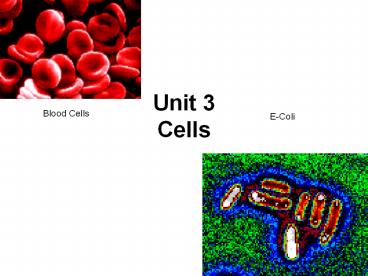Unit 3 Cells - PowerPoint PPT Presentation
1 / 8
Title:
Unit 3 Cells
Description:
Unit 3 Cells Blood Cells E-Coli IV. Prokaryotes vs. Eukaryotes Unit 3 Cells IV. Prokaryotes vs. Eukaryotes The History behind the Cell Theory -1600 s- Anton van ... – PowerPoint PPT presentation
Number of Views:136
Avg rating:3.0/5.0
Title: Unit 3 Cells
1
Unit 3Cells
Blood Cells
E-Coli
2
- The History behind the Cell Theory
- -1600s- Anton van Leeuwenhoek first person to
use a microscope to study nature - -1665- Robert Hooke- Used one of the first light
microscopes to study plant tissue - -When looking at a cork thought that it looked
like monastery cells - -1838- Matthias Schleiden-all plants are made of
Cells - -1839-Theodor Schwann- all animals are made of
Cells - -1855 Rudolf Virchow- a doctor studied Cell
Reproduction - Where a cell exists, there must have been a
preexisting one - These scientists and many others came up with
what we know today as the - drum roll please.
3
II. The CELL THEORY 1.ALL living things are
composed of cells (psst- that means you too) 2.
Cells are the basic units of structure and
function in living things (i.e. they hold you up
and make work) 3. New Cells are produced from
existing cells Question Why do you think it
took so long for the cell theory to be stated?
(1665-1900)-235 years????
4
III. Basic Cell Structures 1. Size- Cells range
from .2 micrometers to 1,000 micrometers (Note 1
micrometer is 1/1000 of a millimeter) 2. Cells
are drastically different in size and shape but
the have certain structures in common ALL known
functioning cells have a. Cell Membrane-thin
flexible layer around the cell- that helps
support and protect the cell (note some cells
have a cell wall) b. Cytoplasm- Is like the
cells blood its squishy stuff that the
organelles float in 70 of the cytoplasma is
Cytosol composed of water, salts, organic
molecules, and enzymes that are necessary for
the cell to catalyze reactions.
5
IV. Prokaryotes vs. Eukaryotes
Prokaryotes Eukaryotes
Small and Simple Large and complicated
-No Nucleus -Floating DNA -Nucleus -DNA in the nucleus
-Cell Membrane, Cytoplasm, Ribosomes -NO other Organelles -Cell Membrane, Cytoplasm, Ribosomes -Organelles
-Cell wall composed of peptidoglycan -Cell wall it is NOT made of peptidoglycan Note Not all eukaryotes have a cell wall
Single Cellular (Colonies) Single Cellular, Muticellular
6
Ex Plants, animals, fungi (some fungi are not
cellular at all?), microorganisms -yeast-unicellul
ar -humans-multicellular
Ex Bacteria (e-coli, staph A)
7
Prokaryotic cells came before eukaryotic cells by
2 billion years
8
Structure Prokaryotic Eukaryotic Eukaryotic
Animal Plants
Cell Membrane Y Y Y
Cell Wall Y N Y
Nucleus N Y Y
Ribosome Y Y Y
E.R. N Y Y
Golgi Apparatus N Y Y
Lysosome N Y N
Vacuole N Small/N Y
Mitochondria N Y Y
Chloroplasts N N Y
Cytoskeleton N Y Y































